High-Power Characteristics of Piezoelectric Transducers Based on [011] Poled Relaxor-PT Single Crystals
Abstract
1. Introduction
2. Field-Dependent Test of [011] Poled Single Crystals
2.1. Test Set-Ups
2.2. Test Results
3. Design and Fabrication of the Transducer
4. Experimental Results and Discussions
4.1. Experimental Set-Ups
4.2. Experimental Results
5. Conclusions
Author Contributions
Funding
Institutional Review Board Statement
Informed Consent Statement
Data Availability Statement
Conflicts of Interest
References
- Zhang, S.; Li, F.; Jiang, X.; Kim, J.; Luo, J.; Geng, X. Advantages and challenges of relaxor-PbTiO3 ferroelectric crystals for electroacoustic transducers—A review. Prog. Mater. Sci. 2015, 68, 1–66. [Google Scholar] [CrossRef] [PubMed]
- Zhang, S.; Li, F.; Yu, F.; Jiang, X.; Lee, H.-Y.; Luo, J.; Shrout, T.R.; Zhang, S.; Li, F.; Yu, F. Recent developments in piezoelectric crystals. J. Korean Ceram. Soc. 2018, 55, 419–439. [Google Scholar] [CrossRef]
- Ewart, L.M.; Mclaughlin, E.A.; Robinson, H.C.; Stace, J.J.; Amin, A. Mechanical and electromechanical properties of PMNT single crystals for naval sonar transducers. IEEE Trans. Ultrason. Ferroelectr. Freq. Control 2007, 54, 2469–2473. [Google Scholar] [CrossRef] [PubMed]
- Sim, M.-S.; Je, Y.; Cho, Y.-H.; Seo, H.-S.; Kim, M.-J. Derivation of equivalent material coefficients of 2-2 piezoelec-tric single crystal composite. Micromachines 2024, 15, 917. [Google Scholar] [CrossRef]
- Zhang, S.; Li, F. High performance ferroelectric relaxor-PbTiO3 single crystals: Status and perspective. J. Appl. Phys. 2012, 111, 031301. [Google Scholar] [CrossRef]
- Zhang, S.; Li, F.; Shrout, T.R.; Luo, J. Relaxor-PT single crystals for various applications. In Proceedings of the ISAF-ECAPD-PFM 2012, Aveiro, Portugal, 9–13 July 2012; pp. 1–4. [Google Scholar]
- Zhang, S.; Lee, S.M.; Kim, D.H.; Lee, H.Y.; Shrout, T.R. Characterization of Mn-modified Pb (Mg1/3Nb2/3) O3–PbZrO3–PbTiO3 single crystals for high power broad bandwidth transducers. Appl. Phys. Lett. 2008, 93, 122908. [Google Scholar] [CrossRef] [PubMed]
- Sun, E.; Zhang, S.; Luo, J.; Shrout, T.R.; Cao, W. Elastic, dielectric, and piezoelectric constants of Pb (In1/2Nb1/2) O3–Pb (Mg1/3Nb2/3) O3–PbTiO3 single crystal poled along [011] c. Appl. Phys. Lett. 2010, 97, 032902. [Google Scholar] [CrossRef]
- Zhang, S.; Xia, R.; Lebrun, L.; Anderson, D.; Shrout, T.R. Piezoelectric materials for high power, high temperature applications. Mater. Lett. 2005, 59, 3471–3475. [Google Scholar] [CrossRef]
- Zhang, S.; Sherlock, N.P.; Meyer, R.J.; Shrout, T.R. Crystallographic dependence of loss in domain engineered relaxor-PT single crystals. Appl. Phys. Lett. 2009, 94, 162906. [Google Scholar] [CrossRef]
- Sherlock, N.P.; Meyer, R.J. Modified single crystals for high-power underwater projectors. IEEE Trans. Ultrason. Ferroelectr. Freq. Control 2012, 59, 1285–1291. [Google Scholar] [CrossRef]
- Sherlock, N.P. Relaxor-PT Single Crystals for Broad Bandwidth, High Power Sonar Projectors; The Pennsylvania State University: University Park, PA, USA, 2010. [Google Scholar]
- Gallagher, J.A.; Tian, J.; Lynch, C.S. Composition dependence of electro-mechanical properties and field induced phase transformations in [001] C PIN–PMN–PT single crystals. Smart Mater. Struct. 2014, 23, 095031. [Google Scholar] [CrossRef]
- Schader, F.H.; Rossetti Jr, G.A.; Luo, J.; Webber, K.G. Piezoelectric and ferroelectric properties of< 001> C Pb (In1/2Nb1/2) O3-Pb (Mg1/3Nb2/3) O3-PbTiO3 single crystals under combined thermal and mechanical loading. Acta Mater. 2017, 126, 174–181. [Google Scholar]
- Luo, J.; Taylor, S.; Hackenberger, W.; Zhang, S. Large field property assessment of Mn: PIN-PMN-PT crystals for high power transducers. In Proceedings of the 2013 Joint IEEE International Symposium on Applications of Ferroelectric and Workshop on Piezoresponse Force Microscopy (ISAF/PFM), Prague, Czech Republic, 21–25 July 2013; pp. 1–4. [Google Scholar]
- Luo, J.; Hackenberger, W.; Zhang, S.; Shrout, T.R. The progress update of relaxor piezoelectric single crystals. In Proceedings of the 2009 IEEE International Ultrasonics Symposium, Roma, Italy, 20–23 September 2009; pp. 968–971. [Google Scholar]
- Huo, X.; Zhang, S.; Liu, G.; Zhang, R.; Luo, J.; Sahul, R.; Cao, W.; Shrout, T.R. Complete set of elastic, dielectric, and piezoelectric constants of [011] C poled rhombohedral Pb (In0.5Nb0.5) O3-Pb (Mg1/3Nb2/3) O3-PbTiO3: Mn single crystals. J. Appl. Phys. 2013, 113, 074106. [Google Scholar] [CrossRef] [PubMed]
- Gallagher, J.A.; Tian, J.; Lynch, C.S. Composition dependence of field induced phase transformations in [0 1 1] C PIN–PMN–PT relaxor ferroelectric single crystals with d322 piezoelectric mode. Acta Mater. 2014, 81, 512–523. [Google Scholar] [CrossRef]
- Sherlock, N.; Garten, L.; Zhang, S.; Shrout, T.R.; Meyer, R.J. Nonlinear dielectric response in piezoelectric materials for underwater transducers. J. Appl. Phys. 2012, 112, 124108. [Google Scholar] [CrossRef]
- Snook, K.A.; Rehrig, P.W.; Hackenberger, W.S.; Jiang, X.; Meyer Jr, R.J.; Markley, D. Advanced piezoelectric single crystal based transducers for naval sonar applications. In Proceedings of the Smart Structures and Materials 2005: Active Materials: Behavior and Mechanics, San Diego, CA, USA, 7–10 March 2005; pp. 263–271. [Google Scholar]
- Rehrig, P.; Snook, K.; Hackenberger, W.S.; Meyer Jr, R.J.; Markley, D. 5D-5 tailored single crystal orientations for improved tonpilz transducer performance. In Proceedings of the 2006 IEEE Ultrasonics Symposium, Vancouver, BC, Canada, 3–6 October 2006; pp. 359–362. [Google Scholar]
- Zhang, K.; Chen, Y.; Peng, K. The study of 32-mode single crystal longitudinal transducer. In Proceedings of the 2016 IEEE/OES China Ocean Acoustics (COA), Harbin, China, 9–11 January 2016; pp. 1–4. [Google Scholar]
- Jones, D.F.; Lewis, D.; Reithmeier, C.; Brownell, G. Barrel-stave flextensional transducers for sonar applications. In Proceedings of the International Design Engineering Technical Conferences and Computers and Information in Engineering Conference, Boston, MA, USA, 17–20 September 1995; pp. 517–524. [Google Scholar]
- Teng, D.; Liu, X.; Gao, F. Effect of concave stave on class I barrel-stave flextensional transducer. Micromachines 2021, 12, 1258. [Google Scholar] [CrossRef]
- Shao, T.; Du, H.; Ma, H.; Qu, S.; Wang, J.; Wang, J.; Wei, X.; Xu, Z. Potassium–sodium niobate based lead-free ceramics: Novel electrical energy storage materials. J. Mater. Chem. A 2017, 5, 554–563. [Google Scholar] [CrossRef]
- Jung, H.-B.; Kim, J.-W.; Lim, J.-H.; Kwon, D.-K.; Choi, D.H.; Jeong, D.-Y. Energy storage properties of blended polymer films with normal ferroelectric P (VDF-HFP) and relaxor ferroelectric P (VDF-TrFE-CFE). Electron. Mater. Lett. 2020, 16, 47–54. [Google Scholar] [CrossRef]
- Perumal, R.N.; Athikesavan, V. Structural and electrical properties of lanthanide-doped Bi0. 5 (Na0. 80K0. 20) 0.5 TiO3–SrZrO3 piezoelectric ceramics for energy-storage applications. J. Mater. Sci. Mater. Electron. 2020, 31, 4092–4105. [Google Scholar] [CrossRef]
- Priya, S.; Viehland, D.; Carazo, A.V.; Ryu, J.; Uchino, K. High-power resonant measurements of piezoelectric materials: Importance of elastic nonlinearities. J. Appl. Phys. 2001, 90, 1469–1479. [Google Scholar] [CrossRef]
- Uchino, K.; Zheng, J.; Chen, Y.; Du, X.; Ryu, J.; Gao, Y.; Ural, S.; Priya, S.; Hirose, S. Loss mechanisms and high power piezoelectrics. J. Mater. Sci. 2006, 41, 217–228. [Google Scholar] [CrossRef]
- Westerhold, S. Total Harmonic Distortion (THD) Analysis Utilizing the FFT Capabilities of Modern Digital Storage Oscilloscopes. 2022. Available online: https://zenodo.org/records/6969825 (accessed on 1 December 2024).
- Neto, L.B.; Coelho, P.H.G.; de Mello, J.C.C.S.; Angulo-Meza, L.; Gomes, E.G. Towards an intelligent system for monitoring electrical energy quality-Foundations and Motivations. In Proceedings of the International Conference on Enterprise Information Systems, Beijing, China, 8–11 June 2011; pp. 40–45. [Google Scholar]
- Je, Y.; Sim, M.-S.; Cho, Y.-H.; Lee, W.-O.; Lee, S.-G.; Lee, J.-M.; Seo, H.-S. Characterization of [011] Poled Pb(In1/2Nb1/2)O3-Pb(Mg1/3Nb2/3)O3-PbTiO3 Single Crystals by Resonance Method. J. Korean Inst. Electr. Electron. Mater. Eng. 2021, 34, 466–474. [Google Scholar]
- Kwon, B.; Pyo, S.; Je, Y.; Seo, H.-S.; Lee, S.; Roh, Y. Precise evaluation of the material constants of [011]-poled mangan-doped 0.32 Pb (In1/2Nb1/2) O3-0.39 Pb (Mg1/3Nb2/3) O3-0.29 PbTiO3 single crystals. AIP Adv. 2024, 14, 045221. [Google Scholar] [CrossRef]
- Zhang, X.; Lin, X.; Guo, R.; Yu, F.; Yang, C.; Huang, S. Influence and mechanism of radial prestress on the electro-acoustic performance of spherical transducers. Sens. Actuators A Phys. 2023, 360, 114538. [Google Scholar] [CrossRef]
- Covaci, C.; Gontean, A. Piezoelectric energy harvesting solutions: A review. Sensors 2020, 20, 3512. [Google Scholar] [CrossRef]
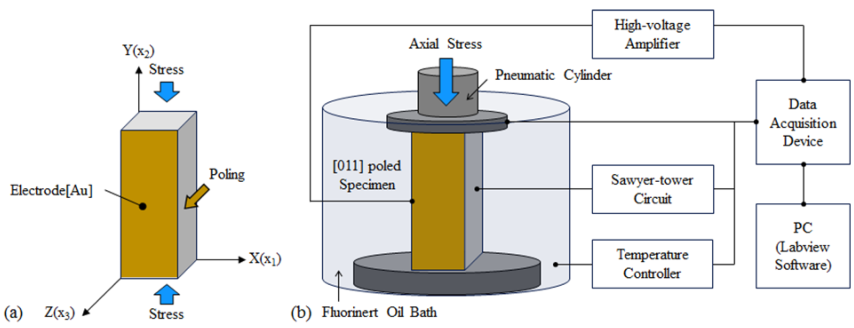
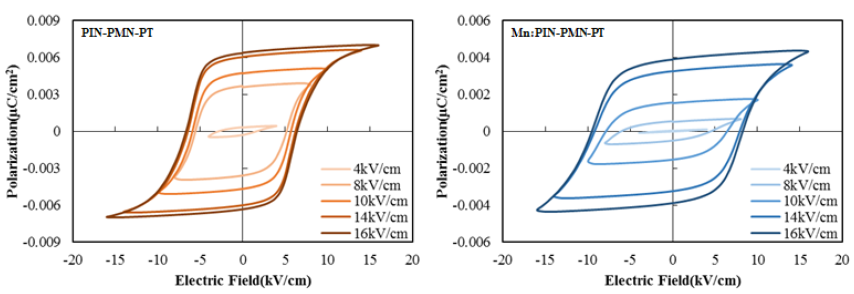


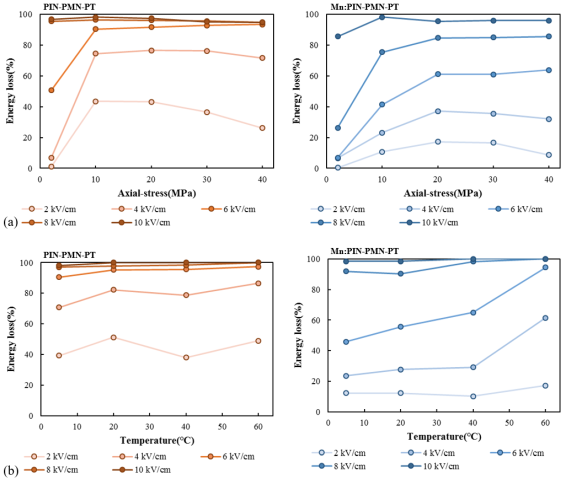


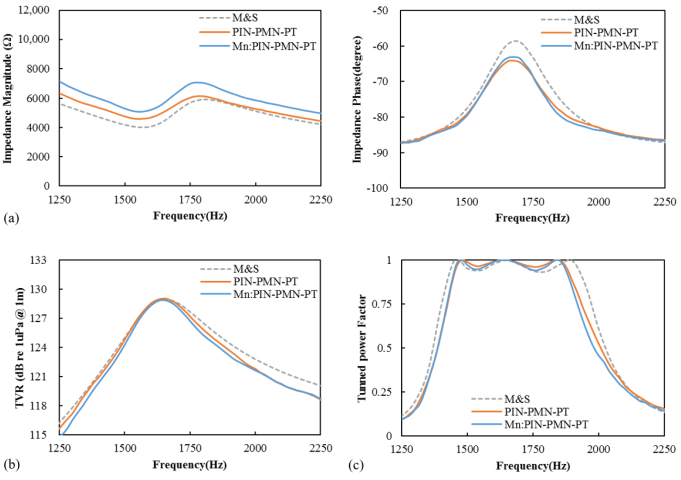


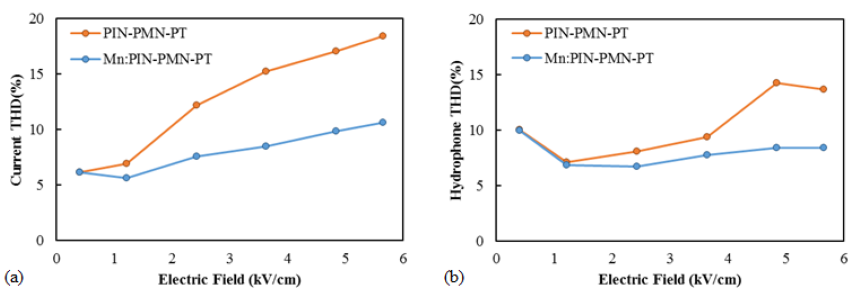
Disclaimer/Publisher’s Note: The statements, opinions and data contained in all publications are solely those of the individual author(s) and contributor(s) and not of MDPI and/or the editor(s). MDPI and/or the editor(s) disclaim responsibility for any injury to people or property resulting from any ideas, methods, instructions or products referred to in the content. |
© 2025 by the authors. Licensee MDPI, Basel, Switzerland. This article is an open access article distributed under the terms and conditions of the Creative Commons Attribution (CC BY) license (https://creativecommons.org/licenses/by/4.0/).
Share and Cite
Lim, S.; Je, Y.; Sim, M.-J.; Kim, H.-P.; Cho, Y.; Jeong, Y.; Seo, H.-S. High-Power Characteristics of Piezoelectric Transducers Based on [011] Poled Relaxor-PT Single Crystals. Sensors 2025, 25, 936. https://doi.org/10.3390/s25030936
Lim S, Je Y, Sim M-J, Kim H-P, Cho Y, Jeong Y, Seo H-S. High-Power Characteristics of Piezoelectric Transducers Based on [011] Poled Relaxor-PT Single Crystals. Sensors. 2025; 25(3):936. https://doi.org/10.3390/s25030936
Chicago/Turabian StyleLim, Soohyun, Yub Je, Min-Jung Sim, Hwang-Pill Kim, Yohan Cho, Yoonsang Jeong, and Hee-Seon Seo. 2025. "High-Power Characteristics of Piezoelectric Transducers Based on [011] Poled Relaxor-PT Single Crystals" Sensors 25, no. 3: 936. https://doi.org/10.3390/s25030936
APA StyleLim, S., Je, Y., Sim, M.-J., Kim, H.-P., Cho, Y., Jeong, Y., & Seo, H.-S. (2025). High-Power Characteristics of Piezoelectric Transducers Based on [011] Poled Relaxor-PT Single Crystals. Sensors, 25(3), 936. https://doi.org/10.3390/s25030936





